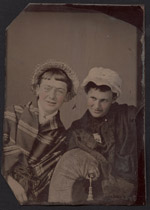Photographic Processes: 1839 – 1889
WET PLATE COLLODION
TINTYPE (ferrotype), 1856-1915
Silver-based, one-of-a-kind image on an iron plate with collodion as the binder to hold light sensitive materials
Similar to an ambrotype, a tintype is a wet-collodion process, but on a dark lacquered iron plate instead of glass. The lacquer forms the dark background required to reveal the positive image. Tintypes are often coated with a protective varnish.
Tintypes can be found in albums, carte de visite size paper mounts, daguerreotype cases and frames. It is often difficult to distinguish a cased tintype from a cased ambrotype.
 |
Unidentified. Tintype, 1880s. [zoom] 5 x 3 1/2 in. Tintypes were less expensive, more durable and easier to produce than both ambrotypes and collodion negatives. Often used by itinerant photographers, tintypes were the closest approximation to instant photography in the 19th century. Tintypes first appeared in the United States in 1856 and remained popular well into the 20th century. |